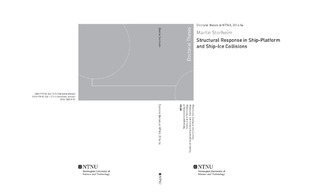| dc.description.abstract | Collision events may have severe consequences, and it is important to design both
ship and offshore structures so that they have sufficient resistance to a collision
event. The main purpose of the work herein is to improve the methods for description
of the material behavior in nonlinear finite element analysis (NLFEA), and to
study the physics of the collision process through numerical simulations of both
experiments and full-scale scenarios. Simplified methods are proposed based on
the findings.
The shape of the stress-strain curve of the steel material is found to have a large
effect on how strains localize in a deformation process, and thereby on the fracture
initiation and propagation. Strain-rate hardening is found to be challenging with
shell elements, especially w.r.t. dynamic fracture strain, and can increase the uncertainty
if not carefully calibrated. Determination of the design material concept
is discussed, ensuring that the materials representing load and resistance are given
appropriate safety factors. A novel way of separating two different mesh scale
effects termed geometric and material is proposed.
The micromechanical process of fracture is discussed, and related to the macromechanical
process that can be captured with coarse shell elements. The dependence
of strain-state and length scale is investigated. Many of the popular
fracture criteria are implemented in LS-DYNA and a large simulation program is
conducted with different experiments and many mesh sizes. The accuracy of the
fracture criteria is assessed.
An extension of the BWH fracture criterion is proposed, in which post-necking
effects can be included. Through a combination of coupled damage and a strainstate
dependent erosion criterion, a more robust fracture prediction with reduced
mesh dependence is achieved.
NLFEA is used as virtual experiments to study supply vessel collisions with offshore
platforms. A pressure-area relation is proposed for the pressures required
to initiate crushing of the bulbous bow of a supply vessel. A simplified model is
proposed for strength-design of stiffened panels, combining a roof-top mechanism
with the stiffener shear capacity in an incremental approach. A refined method for
strength-design of jacket legs and braces is proposed, based on the characteristic
strength Rc.
Various challenges related to simulation of ice collision events are discussed, especially
with respect to the material behavior of ice during fast compressive loading.
The material behavior of ice is not well known, and has large statistical variations
in properties. During a collision with damage to the ship, the changed geometry of the ship side will increase the confinement of the ice, thereby increasing its
crushing pressure. All ice loads given in current rules and standards disregard this
effect.
Two experimental campaigns are performed to study the coupled deformation process
as both ice and structure deforms, thereby investigating the effect of the confinement.
The load exerted from the ice increases significantly when the structure
deforms plastically, indicating that the coupled effect is important. The effect
should be considered in updated rules and standards. | nb_NO |
